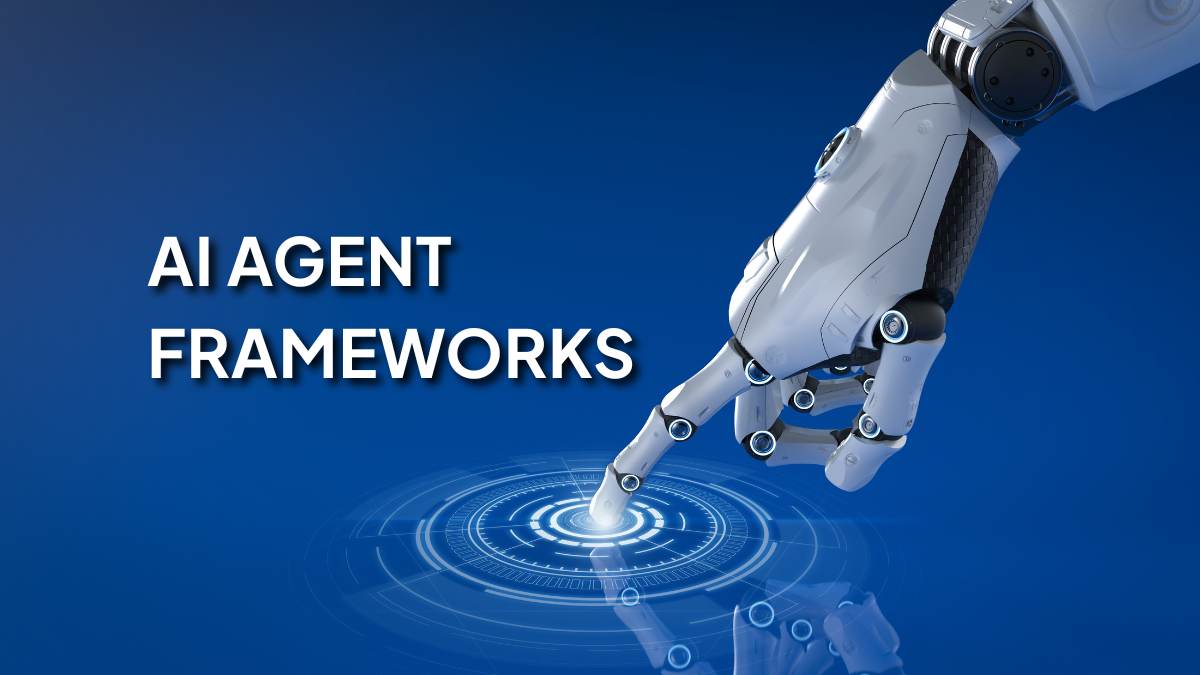AI agent frameworks are toolkits that help developers build autonomous AI agents, software entities that can reason, plan, and execute tasks using large language models (LLMs) like GPT-4 or Claude. These frameworks streamline everything from memory and tool usage to task orchestration and collaboration. Whether you’re building a personal assistant, automating internal ops, or experimenting with multi-agent teams, these frameworks are the foundation that makes it all possible.
Table of Contents
What are AI Agent Frameworks?
Think of AI agent frameworks like the “operating systems” for AI agents.
They’re not the agents themselves, but they provide all the building blocks, task planning, memory, tool integration, multi-agent collaboration, so that developers don’t have to start from scratch every time they want to build something smarter than a basic chatbot.
With the explosion of powerful LLMs like GPT-4, Claude, Gemini, and open models like LLaMA 3, developers (and even non-developers) are now creating applications where AI does more than just answer questions, it can think, decide, and do. And agent frameworks make that leap possible.
Why Do You Need an AI Agent Framework?
It’s a good question, why not just use the OpenAI API directly or plug ChatGPT into your app?
Well, you can do that. But as soon as you want the AI to perform multi-step tasks, call APIs, remember things, or coordinate with other agents… it gets messy. Fast.
Here’s what agent frameworks help with:
- Automating Multi-Step Tasks: Instead of a single response, agents can think through a series of steps. For example, researching a product, checking prices via API, and sending a summary to your Slack.
- Tool and API Integration: They can interface with databases, webhooks, calculators, calendars, basically any external tool, so your AI isn’t just guessing, it’s doing.
- Context and Memory Management: Agents can remember previous steps, decisions, or user preferences. That means fewer “Sorry, I forgot what we were talking about” moments.
- Decision-Making and Planning: With built-in planners and executors, agents can reason through branching logic, retry failed steps, or coordinate with other agents.
- Faster Development Time: You’re not reinventing the wheel. These frameworks come with modular tools and libraries, saving devs hundreds of hours.
- Turning LLMs into Agents, Not Just Chatbots: This is the big one. Without a framework, an LLM is just a clever text predictor. With one, it becomes a digital teammate.
Also Read: What is Agentic AI?
How to Choose the Right AI Agent Framework
There’s no single “best” agent framework, just the best one for your use case. Whether you’re building a customer support bot, automating reports, or building an AI teammate to co-write with you, here are a few key things to think about before picking one.
1. Complexity & Learning Curve
- Is it beginner-friendly, or will you need to study it like a new programming language?
- For example, LangChain is powerful but comes with a bit of a learning curve. SmolAgents, on the other hand, is simpler and easier to prototype with.
2. Extensibility & Customization
- Can you plug in your own tools, APIs, and logic?
- CrewAI, for instance, lets you define very specific agent roles and how they collaborate on tasks, which is great for complex workflows.
3. Security & Data Privacy
- Does the framework support on-premise deployment or encryption?
- This matters a lot for sectors like healthcare or finance. Tools like Phidata and Semantic Kernel were built with enterprise use and security in mind.
4. Performance & Scalability
- Will it break when you scale to dozens or hundreds of agents? Can it handle large workflows?
- LangGraph shines here, with features like retry logic, branching, and state management baked in.
5. Ecosystem & Community
- Is there a strong dev community, good docs, regular updates?
- LangChain has a massive ecosystem right now. You’ll find tons of extensions, templates, and YouTube explainers.
6. Integration Capabilities
- Does it play nicely with your existing stack, Python, REST APIs, vector databases like Pinecone, or tools like Zapier?
- Frameworks like LlamaIndex are specifically designed to work with vector DBs and RAG pipelines.
Top 10 AI Agent Frameworks in 2025
This isn’t just a list, it’s a curated set of frameworks that are actually being used in the wild, across industries and teams.
1. LangChain
What it is:
A flexible framework to build powerful LLM applications by chaining together tools, memory, and agents.
Key features:
- Prebuilt chains and agents
- Tool integration (APIs, calculators, retrievers)
- Long-term memory and state handling
- Works well with vector DBs (Pinecone, FAISS)
Ideal use case:
Building production-ready apps like AI customer service agents, research assistants, or workflow automation bots.
2. LangGraph
What it is:
A graph-based orchestration framework built on top of LangChain, focused on deterministic, multi-step logic.
Key features:
- Graph nodes = steps in your logic
- Built-in retry, branching, and state management
- Powerful debugging and observability
Ideal use case:
Complex workflows that involve conditional logic, think “if this fails, try that,” or “do X before Y but only if Z.”
3. Microsoft Semantic Kernel
What it is:
An SDK for building AI agents with memory, tools, and planner plugins, available in both Python and .NET.
Key features:
- Supports skills and semantic functions
- Plugin system for tool integration
- Memory and goal-based planners
- Strong enterprise support from Microsoft
Ideal use case:
Enterprise-grade agents for internal tools, reporting systems, or secure document handling.
4. AutoGen by Microsoft
What it is:
A framework for building multi-agent conversations where agents (and even humans) talk to each other and complete goals.
Key features:
- Multi-agent chat orchestration
- Function calling and tool usage
- Parallel task execution
- Human-in-the-loop workflows
Ideal use case:
Collaborative agents that mimic a team of specialists, think coding copilot + debugger + researcher all working together.
5. CrewAI
What it is:
A framework where agents are assigned specific “roles” and collaborate like a human team with a shared goal.
Key features:
- Role-based agents (e.g., Researcher, Writer, Strategist)
- Goal coordination and dependency management
- Built-in memory and communication between agents
Ideal use case:
Collaborative tasks like content creation, marketing strategy, or planning events, where each agent has a defined role.

Enroll Now: AI Marketing Course
6. LlamaIndex (formerly GPT Index)
What it is:
A data framework that lets you hook up your own private data sources (like PDFs, Notion docs, SQL databases) to your AI agent.
Key features:
- Retrieval-Augmented Generation (RAG) ready
- Built-in connectors for vector DBs (like Weaviate, Pinecone)
- Works great with LangChain, OpenAI, etc.
- Easy to add your own structured or unstructured data
Ideal use case:
Building agents that need to answer questions based on your internal knowledge base, like an internal HR assistant or a legal doc summarizer.
7. SmolAgents
What it is:
A minimal, lightweight agent framework made by indie developers. Super simple, kind of like the “just enough” version of an agent builder.
Key features:
- Easy tool definition
- Single-file, readable architecture
- Doesn’t try to do everything, just gets out of your way
Ideal use case:
Prototyping fast. Like… you have a weekend and want to build a smart AI task runner. Or maybe you’re just testing out an idea before going full production.
8. Phidata
What it is:
A modular framework focused on building production-grade AI agents with observability, logging, and monitoring baked in.
Key features:
- Modular architecture
- Structured logging (great for debugging)
- Supports dashboards, live observability
- Great tool integration support
Ideal use case:
Enterprise teams that need visibility into what the agent is doing. Think healthcare, finance, SaaS back-office automation.
9. OpenAI Swarm (Experimental)
What it is:
An experimental concept from OpenAI where agents operate in a swarm, kind of like how bees or ants coordinate. Inspired by swarm intelligence from nature.
Key features:
- Multi-agent communication
- Decentralized decision-making
- No public SDK yet, but early examples are floating around
Ideal use case:
Still early, but really interesting for future collaborative use cases, like real-time traffic routing, logistics optimization, or swarm-style creative ideation.
10. Botpress
What it is:
A visual platform to build chatbot-style agents with NLP capabilities and backend API integration. Focused more on customer experience than general AI automation.
Key features:
- Drag-and-drop flow builder
- Supports natural language understanding
- Integrates with CRMs, Helpdesks, Calendars, etc.
- Good analytics + live debugging
Ideal use case:
Customer service, lead qualification, appointment booking. Basically, anything where you want a polished, no-code interface plus smart conversations.
Optional Mentions (Still Worth Knowing About):
- RASA: Great for NLU-focused bots and voice assistants. A bit more complex, but rock-solid.
- AgentFlow: Like a visual LangChain with logic flows, really helpful if you’re more of a designer than a coder.
- ChatDev: A fun open-source project where agents take on “developer roles” and collaborate to ship code.
- Langflow: Drag-and-drop visual builder for LangChain apps. Useful for quick prototyping and teaching.
Also Read: 10 Essential Skills to Build AI Agents
Agent Framework Comparison Table
Here’s a quick side-by-side to help you filter things fast:
| Framework | Best For | Language Support | Open Source | Key Feature |
| LangChain | Complex LLM workflows | Python | ✅ | Chains, tools, memory |
| Semantic Kernel | Enterprise Devs (.NET, Python) | Python, C# | ✅ | Plugins, memory, planners |
| AutoGen | Multi-agent convos | Python | ✅ | Conversational agents, function calling |
| CrewAI | Team-style agents | Python | ✅ | Role-based collaboration |
| LlamaIndex | RAG-based data agents | Python | ✅ | Private data + vector DB support |
Also Read: LLM vs Generative AI: Key Differences
Key Components of an AI Agent
Okay, let’s break down what actually makes an “AI agent” tick. Most of these frameworks will have some or all of these components baked in, even if they call them different things.
1. Planner
This part figures out what needs to happen next. It might decide: “Search for this,” then “Summarize the result,” then “Email it to the user.”
2. Executor
Once the plan is made, the executor actually runs the tasks. That might mean calling an API, launching a browser, or triggering a webhook.
3. Memory
Memory allows the agent to remember what just happened, or what happened 10 interactions ago. It can be short-term (in-session) or long-term (across sessions).
4. Tool Use / API Access
This is what allows the agent to step outside of its language model bubble and actually do things. Like querying a database, sending a Slack message, or generating a spreadsheet.
5. Communication Layer
For multi-agent setups (like in AutoGen or CrewAI), this layer allows agents to talk to each other, or even talk to humans in the loop. Super useful for team-style collaboration.
6. Prompt Engine
The prompt engine dynamically crafts prompts based on what the agent is doing or who it’s talking to. It’s how the agent knows what to say, how to say it, and when.
Also Read: Rational Agents in AI: Working, Types and Examples
Real-World Use Cases of AI Agent Frameworks
Sometimes all this agent talk feels theoretical, until you see what people are actually building. Here are a few practical, real-world examples of how AI agent frameworks are being used right now:
1. Zapier + LangChain
Use case: Automating lead enrichment
You’ve got a new lead coming in from a Typeform. Zapier kicks off a LangChain-powered agent that looks up the person’s LinkedIn profile, checks if their email is valid, adds some firmographic info from Clearbit, and drops the enriched data into your CRM.
Totally hands-off. Zero copy-pasting. Lead gen team’s happy.
2. Phidata in Healthcare
Use case: Secure AI agents writing discharge summaries
A hospital uses Phidata to build agents that summarize doctor notes, lab reports, and medication data into structured discharge summaries. It’s secure (HIPAA-compliant setup), fully auditable, and plugs directly into their EHR system.
Doctors save hours per week, and admin errors go way down.
3. CrewAI for Content Teams
Use case: Research and outline automation
Imagine a content strategist using CrewAI with three agents: one for topic research, one for competitor analysis, and one for outline generation. Each agent has a role and collaborates on the task. By the time the human shows up, there’s a detailed blog outline waiting.
That’s hours saved, and ideas you might’ve missed if you were working solo.
These are just a few, but the point is: AI agents aren’t theoretical anymore. They’re quietly reshaping workflows behind the scenes.
Conclusion: The Future of AI Agent Frameworks
Here’s the thing: large language models were never meant to just sit in chat windows answering questions. They’ve got way more potential than that.
With agent frameworks, we’re seeing that potential finally get unlocked.
Instead of treating GPT or Claude like a chatbot, developers are turning them into task-driven, multi-functional, collaborative entities. And once you start chaining them together, or giving them tools, memory, and goals, the line between “software” and “assistant” starts to blur.
We’re also seeing a big push toward multi-agent collaboration. One agent might be in charge of researching. Another might handle writing. A third might verify facts or send updates to Slack. All talking to each other, working as a team.
If you’re even slightly curious about building in AI, now’s honestly a great time to dive in.
There’s never been this much tooling, support, and open-source momentum around intelligent automation.
FAQ: AI Agent Frameworks
Q1: What is an AI agent framework?
It’s basically a toolkit that helps you build smart assistants using AI models like GPT-4. These assistants can plan steps, use tools, and act more like problem-solvers than chatbots.
Q2: Which is the best AI agent framework in 2025?
It really depends on what you’re building. LangChain’s great for workflows, AutoGen is ideal for teamwork between agents, and Semantic Kernel shines in enterprise settings. Pick based on your goals and tech stack.
Q3: Can I use AI agent frameworks without coding?
Some platforms like Botpress or Langflow let you build with little or no code. But honestly, for most frameworks, knowing a bit of Python goes a long way.
Q4: How do AI agents differ from chatbots?
Chatbots usually just respond to inputs with pre-written replies. AI agents, on the other hand, can actually think through steps, call tools, and make decisions on the fly.
Q5: Are these frameworks free to use?
Most are open-source or have a free tier, like LangChain or LlamaIndex. But if you’re building something at scale or for enterprise, you might run into some paid features.

